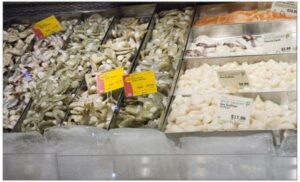Whole Foods Pulls the Line on ‘Overfished’ Seafood Out of All Stores

Whole Foods Market, the nation’s leading natural and organic supermarket chain, has announced effective Earth Day (April 22), the retailer will be the first national grocer to no longer offer its customers any seafood carrying a “red rating,” which the Blue Ocean Institute and the Monterey Bay Aquarium use to identify species that are either being overfished or employ methods used in catch that put ecosystems and other marine life at risk.
Among the fish that will be discontinued by the retailer are Atlantic halibut, grey sole and skate. And the retailer will continue to purchase farmed fish, having the highest standards in the industry, according to a company spokesperson. “We require traceability from fishery to market and rely on a third party to ensure our standards are being met.” The sustainability-heavy standards also prohibit cloned or genetically modified fish, the use of any antibiotics, growth hormones or poultry and mammalian by-products in feed.
This move isn’t the first of its kind for the retailer, either. In 2006, Whole Foods pulled all its live lobster tanks, except for closely monitored ones in Maine. In 2004, the chain made purchasing only cage-free eggs a company-wide policy. And last year, the supermarket implemented the Global Animal Partnership’s 5-Step Animal Welfare Rating. While that particular rating system has been criticized by animal welfare organizations as giving too much leeway to notorious animal offenders such as Purdue, taking bold steps in food quality has been Whole Foods’ modus operandi, and highlighting ethical animal treatment is a growing concern for consumers.
Whole Foods relies on the leading fishery certification program offered by the Marine Stewardship Council on fish including Alaska salmon, Pacific halibut, Nova Scotia harpoon-caught swordfish and Pacific cod. Fish not certified through the MSC program must meet the Blue Ocean Institute and Monterey Bay Aquarium’s ratings: green or “Best Choice” means the species are not in danger and are caught in environmentally friendly ways and yellow or “Good Alternative” means some concerns exist with the species or catch methods.
Keep in touch with Jill on Twitter @jillettinger
Image: swanksalot

